
Pest Library
A Guide To Pest Identification In Phoenix, AZ
From the tiniest bugs to the largest rodents, when pests get into your home or business, they usually bring with them a dose of discomfort and a lot of questions. Let Bug Science help calm your fears and answer your questions. Our pest library provides information about the most common pests in our area, including what problems they can cause and – more importantly – how to get rid of them.
-
Ants
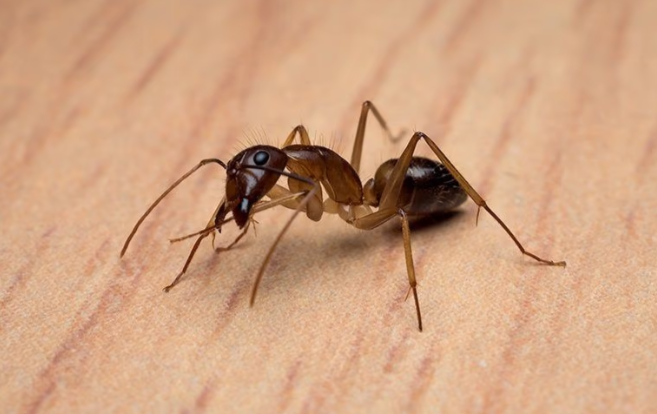
 Ants come in a variety of sizes and shapes, and have different behaviors. One thing they do have in common is that they regularly invade our homes and businesses. Within each ant colony, the members divide into different castes, or groups: males, workers, and queens. Workers (sterile females) make up the bulk of the colony, and are wingless. They are responsible for gathering food, feeding the larvae, defending the colony, and maintaining the nest. These are the ants most often seen walking around our yards and the inside of our homes. Queens are fertile females and lay all the colony’s eggs. Males only have one job which is to mate with the queen(s). Males and queens are the only members of the colony that have wings.
Ants come in a variety of sizes and shapes, and have different behaviors. One thing they do have in common is that they regularly invade our homes and businesses. Within each ant colony, the members divide into different castes, or groups: males, workers, and queens. Workers (sterile females) make up the bulk of the colony, and are wingless. They are responsible for gathering food, feeding the larvae, defending the colony, and maintaining the nest. These are the ants most often seen walking around our yards and the inside of our homes. Queens are fertile females and lay all the colony’s eggs. Males only have one job which is to mate with the queen(s). Males and queens are the only members of the colony that have wings.Some of the most common species of ants that home and business owners in our area deal with are house ants, Caribbean ants, Argentine ants, and carpenter ants. Ants find their way onto properties when they provide them with suitable places to nest or places to gather food to feed their colony. Once workers discover a suitable food source, they will leave behind a pheromone trail for the rest of the workers to follow. The pheromone trail is why you often see long trails of ants moving over fence lines, walkways, and your kitchen.
Ants typically make their central nest outside but will move inside to nest while escaping harsh weather or after discovering easy access to food. Inside, ants like to place their nests near areas of moisture behind walls, under floors, in crawl spaces, or attic spaces.
How to avoid ants: Prevent problems with ants by reducing areas of excess moisture by repairing leaky pipes, clogged gutters, and standing water. Ants also love an indoor or outdoor space that provides them with easy access to food. Open trash cans, pet food, gardens, dirty dishes, or food left out on counters attract ants. Make sure to remove trash from your home daily, and store it in containers with locking lids until trash day. Move out and clean behind large appliances to get rid of grease and other debris. Stop ants from moving into your home by sealing openings in the foundation and exterior walls, install door sweeps, and place covers over vents, drains, and other openings.
-
Cockroaches
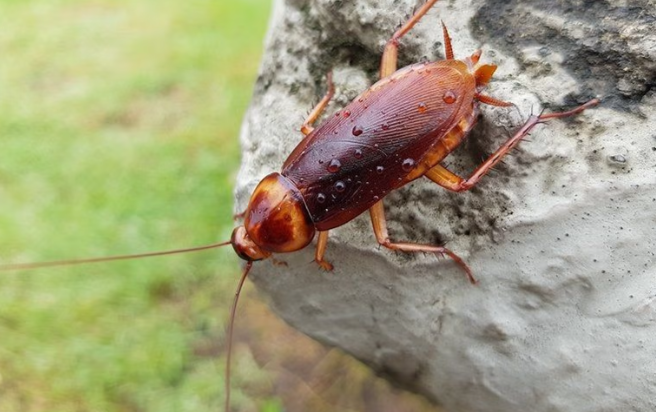 There are thousands of species of cockroaches that live worldwide. While most live outside, far away from people, a handful of cockroach species have made a name for themselves by commonly invading our homes and businesses. In our area, the species we regularly run into are the American cockroach, the Oriental cockroach, the brown-banded cockroach, and the German cockroach.
There are thousands of species of cockroaches that live worldwide. While most live outside, far away from people, a handful of cockroach species have made a name for themselves by commonly invading our homes and businesses. In our area, the species we regularly run into are the American cockroach, the Oriental cockroach, the brown-banded cockroach, and the German cockroach.Cockroaches that are problematic for people are those that rely on us for some of their food and shelter needs. Most species are attracted to moisture and find their way into our homes either to escape unsuitable weather, or while out and about foraging for food. Our homes often offer a wide variety of crumbs, spills, and other food sources for them to nibble on.
Once cockroaches make their way into a home, they hide in dark cracks and crevices, search for food, reproduce, and quickly take over. At the first sign of cockroaches, it is crucial to contact a professional and have the situation taken care of as soon as possible. In addition to their overwhelming presence, the biggest concern when it comes to cockroaches is the health issues they can create for us. Cockroaches are dangerous pests; they carry a variety of bacteria, parasites, and pathogens on their bodies and can contaminate food, food prep areas, dishes, utensils, and other surfaces. Cockroaches spread salmonella, E. coli, and other diseases that cause gastrointestinal issues. Cockroaches also trigger allergies and asthma attacks through their shed skins and excrement; this is mainly a concern in young children.
How to avoid cockroaches: Keep your home and property free of as much food debris, excess moisture, and other clutter. Make sure to store garbage bags in containers with locking lids until it is trash day. Inside, regularly wipe down counters and tables and vacuum or sweep to get rid of crumbs. Limit cockroach access into your home by sealing gaps in exterior walls or the foundation. Inspect boxes, packages, and potted plants for cockroaches before bringing them inside. Reduce sources of moisture that attract many species of cockroaches by fixing leaky pipes, repairing dripping air conditioners, and using dehumidifiers in basements. Be able to discover a cockroach infestation sooner, rather than later, by keeping clutter in your home to a minimum.
-
Mosquitoes
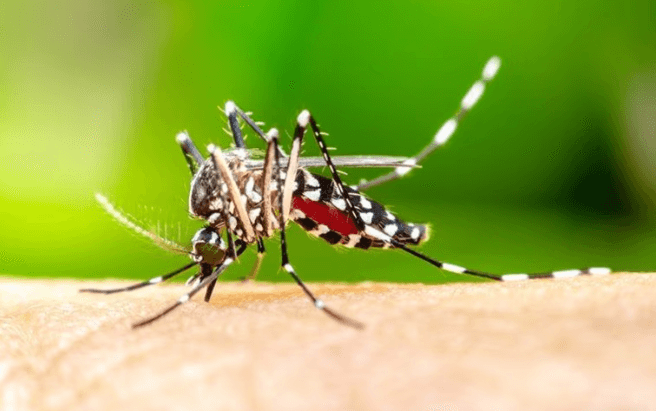 Flying pests that bite us - leaving behind swollen, itchy welts and ruin the time we spend outside with family or friends - mosquitoes are not a pest anyone wants living on their property in large numbers. Mosquitoes are fly-like insects; females feed on the blood of people and animals to obtain the protein needed to produce eggs. Mosquitoes use their proboscis (a specialized elongated mouthpart) to pierce the skin of their victim to feed on their blood. Both males and females use the proboscis to feed on plant nectar, which is their primary source of food. Mosquitoes live and breed outside, making them hard to control. Adding insult to injury is the fact that new mosquitoes can develop from egg to adult within ten days, and each female is capable of laying 500 eggs throughout its short life.
Flying pests that bite us - leaving behind swollen, itchy welts and ruin the time we spend outside with family or friends - mosquitoes are not a pest anyone wants living on their property in large numbers. Mosquitoes are fly-like insects; females feed on the blood of people and animals to obtain the protein needed to produce eggs. Mosquitoes use their proboscis (a specialized elongated mouthpart) to pierce the skin of their victim to feed on their blood. Both males and females use the proboscis to feed on plant nectar, which is their primary source of food. Mosquitoes live and breed outside, making them hard to control. Adding insult to injury is the fact that new mosquitoes can develop from egg to adult within ten days, and each female is capable of laying 500 eggs throughout its short life.The biggest attractant to any property for mosquitoes is standing water, which is where females lay their eggs. From a pond to water that has collected on a soda can rim, any amount of standing water may act as a mosquito breeding site. In addition, properties located near marshes, drainage ditches, or wooded areas tend to have high populations of mosquitoes. They also like to rest during the day in dense shrubbery, tall grasses, and under decks.
Mosquitoes are deadly pests and feed on a variety of people and animal hosts, which gives them the ability to acquire and transmit a variety of diseases that make people ill. Mosquitoes also pose a danger to our pets; they spread potentially fatal parasitic heartworms to cats or dogs. While not all mosquitoes carry diseases and parasites, it is essential to avoid as much contact with mosquitoes as possible. To do this, it would be best to call in a mosquito control professional to get the job done.
How to avoid mosquitoes: Remove or store containers that collect water upside down when not in use, such as flower pots, wheelbarrows, buckets, and wading pools. It is also a good idea to shake off the water that collects on the tops of trash cans or tarps. Gutters and downspouts should be clear of debris to stop them from collecting water. Remove resting spots from your yard by keeping the grass cut short and cutting back overgrown shrubs. If possible, avoid going outside when mosquitoes are most active, which is at dawn and dusk. Keep windows and doors closed as much as possible and repair loose or torn screens to stop mosquitoes from finding their way into your home.
-
Rodents
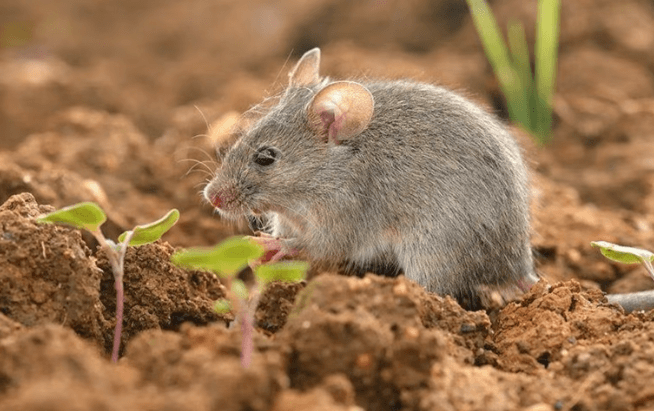 House mice, roof rats, Norway rats, and field mice all have two things in common. First, they are all species of rodents, and second, they are all common invaders inside homes and businesses. A rodent infestation is not only an annoying problem to deal with, but a dangerous one as well. To keep their front incisors sharp and to prevent their teeth from overgrowing, they continuously chew on anything they come across. These chewing habits lead to structural damage, fires, and leaks. Rodents also carry and spread a variety of bacteria, viruses, and parasites and can contaminate surfaces, dishes, utensils, and food.
House mice, roof rats, Norway rats, and field mice all have two things in common. First, they are all species of rodents, and second, they are all common invaders inside homes and businesses. A rodent infestation is not only an annoying problem to deal with, but a dangerous one as well. To keep their front incisors sharp and to prevent their teeth from overgrowing, they continuously chew on anything they come across. These chewing habits lead to structural damage, fires, and leaks. Rodents also carry and spread a variety of bacteria, viruses, and parasites and can contaminate surfaces, dishes, utensils, and food.At the first signs of rodents living in or around your home, it is best to contact a rodent control professional to identify these intruders and quickly eliminate the infestation.
Mice and other rodents have a high metabolism and require a steady supply of food. If your yard, home, or business offers any rodents with appropriate shelter and food, they will take advantage. Sources of food that often attract foraging rodents include open trash cans, compost areas, gardens, pet food, birdseed. After becoming comfortable foraging for food in our yards, it is common for mice, rats, and other rodents to find their way into our homes while searching for additional food sources. Inside, they will feast on anything they come across in the kitchen, pantry, or anywhere else food is stored.
Because rodents do not hibernate, they can find their way onto your property or into your home at any time of year. Along with not hibernating, it is important to note that rodents like to nest near their food sources. Also, rodents often move into our homes to escape unsuitable weather conditions.
How to avoid rodents: Avoid rodents by limiting their easy access to food. Remove bird feeders from your property or place them at the perimeter of your yard away from your home. Pick up uneaten pet food and keep locking lids on trash cans and compost bins. If you have gardens or fruit trees on your property, make sure to regularly harvest the crops and pick up those that have fallen to the ground. Fill in ground holes in your yard and around the foundation of your home, garage, or shed. Rodents love to hide out of sight of people and predators. Cut back overgrown shrubbery from your house where rodents can hide. To keep rodents out of your home, inspect the exterior and seal off any entry points that you find. Remember that mice can enter through spaces that are only the diameter of a pencil and rats through spaces the width of a quarter!
-
Scorpions
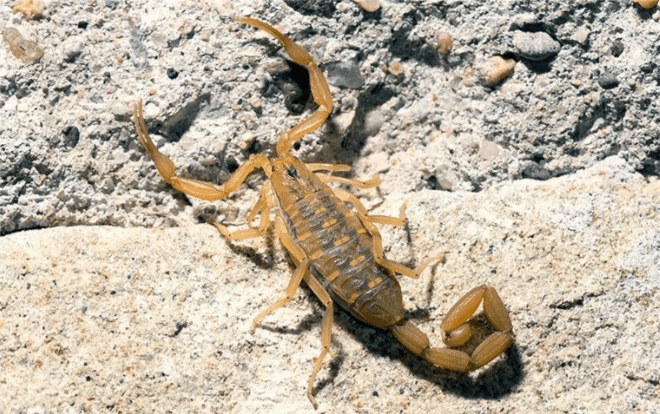 Scorpions are a type of stinging pest that lives throughout Arizona. The stinger they use to deliver their painful stings is at the end of their curved, segmented tail. Scorpions are dangerous because their venom is strong enough to trigger allergic (sometimes severe) reactions in some people. Species of scorpions that find their way into our yards and homes include the Arizona bark scorpion, the Arizona stripetail scorpion, and the Arizona giant hairy scorpion.
Scorpions are a type of stinging pest that lives throughout Arizona. The stinger they use to deliver their painful stings is at the end of their curved, segmented tail. Scorpions are dangerous because their venom is strong enough to trigger allergic (sometimes severe) reactions in some people. Species of scorpions that find their way into our yards and homes include the Arizona bark scorpion, the Arizona stripetail scorpion, and the Arizona giant hairy scorpion.Scorpions are predators and hunt through touch and vibrations because of their poor eyesight. These arachnids are helpful by feeding on nuisance insects, spiders, mice, and small lizards. Scorpions have high moisture needs, and therefore properties with leaky hoses, dripping pipes, clogged gutters, and areas of standing water are places that attract scorpions. Outside, scorpions hide behind tree bark, under mulch, within woodpiles, under logs, and between rocks. Scorpions will move indoors if it becomes too hot and dry outside or while following their food inside. Inside, these creatures hide in dark, humid areas like basements, bathrooms, laundry rooms, and crawl spaces. They often climb walls or into sinks or bathtubs.
If you discover scorpions on your property, it is important to reach out to a scorpion control professional to get rid of these dangerous pests.
How to avoid scorpions: Remove things from your yard that could act as a place for them to live like logs, fallen trees, piles of leaves, and other debris. Prevent scorpions from finding their way into your home by inspecting its exterior walls and sealing any openings you find. Also, repair loose or torn screens and place covers over vents. Eliminate their easy access to moisture by repairing leaky pipes, ventilating crawlspaces, and using dehumidifiers and air conditioners. Take care and wear gloves when working outside in garden areas or storage areas so that you don’t make direct contact with scorpions. Clear overgrown shrubbery and tree branches away from the outside of your home.
-
Termites
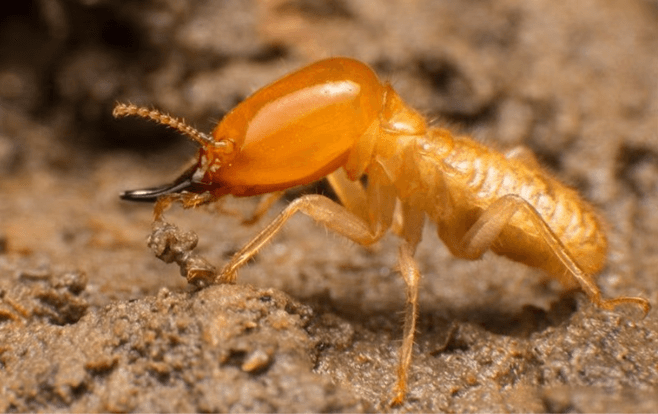 Termites are dangerous and unwanted pests not because they bite people or transmit diseases, but because of the extensive structural damage they can cause inside our homes or businesses. Termites move through the soil and into our structures unnoticed and can work for months or even years before we discover them. The damage termites cause across the country each year is significant; more than five billion dollars! Partnering with a professional termite control company is the best way to eliminate current problems you are having with wood-eating pests and as a way to prevent termites from using your home’s structural wood to feed their massive colonies.
Termites are dangerous and unwanted pests not because they bite people or transmit diseases, but because of the extensive structural damage they can cause inside our homes or businesses. Termites move through the soil and into our structures unnoticed and can work for months or even years before we discover them. The damage termites cause across the country each year is significant; more than five billion dollars! Partnering with a professional termite control company is the best way to eliminate current problems you are having with wood-eating pests and as a way to prevent termites from using your home’s structural wood to feed their massive colonies.Termites are wood-eating, moisture-seeking pests that live together in large colonies and invade properties in large numbers. Termites most often find their way indoors through spaces in the foundation where they then begin attacking wooden joists and the structural wood behind walls and under floors. Termites also move inside through pieces of wood, making direct contact with the ground, such as deck posts, porch steps, wooden playsets, wood shingles, or trim. Once they have found a reliable food source, they will work together day and night throughout the entire year to feed their colony, and only stop if forced to through reliable pest control solutions.
How to avoid termites: Get rid of excess moisture in and around your home. Cut shrubs away from exterior walls, replace wet, decaying mulch with rubber mulch or crushed rocks, create a barrier between the soil and your home’s foundation. Other ways to reduce moisture levels include ventilating crawl spaces, repairing leaky pipes and faucets, and using dehumidifiers. Prevent water from pooling around the foundation of your home by making sure gutters are clear and directing water away from your home.
If you are looking for effective pest control for your Arizona home or business, look no further than Bug Science! For more information about our Phoenix, AZ home pest control or commercial pest control services, give us a call today.
Real Reviews From Those We've Helped
Bug Science received an average rating of 5.0 out of 5 stars from over 150 reviews on Google.
-
"Kept us informed"
Our experience with Bug Science has been wonderful. Thanks, Bug Science, look forward to many more services.
- Joshua R. -
"Thanks Stuart and Bug Science"
Always an easy quarterly service with friendly on time technicians and good communications for upcoming reminders etc.
- Ali P. -
"Would recommend"
Absolutely the best pest control service throughout the Valley. Always responsive, on time, communication is above and beyond.
- Danielle B. -
"They make you feel like family"
His concern for my home and my dogs was exceptional and made it feel so personal. The office staff was so responsive and the techs were fantastic. What more could I ask for!
- Joni V. -
"An absolute pleasure to work with!"
They were so friendly and professional - an absolute pleasure to work with! I'm so thankful we decided to go with Bug Science for our treatment!
- Nic -
"Amazing company!"
My neighbors and I are very grateful for this company and their pricing is extremely competitive!! Thank you, thank you Bug Science, you have a customer for LIFE!!!!!
- Claudia F. -
"Knowledgeable and professional"
The two techs who have serviced our home, Spence and James, are awesome to work with. They provide us a quality service at a reasonable price.
- Alan B. -
"Best of all, she listens to my concerns"
Jess is always great and does a thorough job. Takes her time doing it the right way and does more than a casual spray.
- S.D.


Get started with effective pest control services in Phoenix, AZ. Schedule an appointment with our local company today.